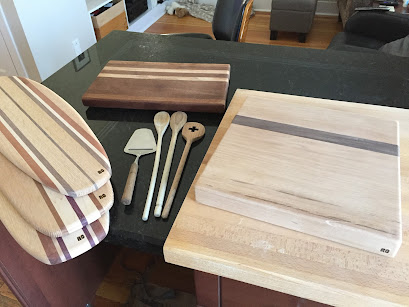I hope you are enjoying the use of your RC Board Works custom woodcraft item! With proper care and maintenance, it should provide you a lifetime of service.
When you first received your board, it was coated with a wax/oil treatment at the factory. This gives the board somewhat water-repellent properties, but this coating diminishes with use. When cleaning, simply wipe the board with a damp cloth, and let it air dry; do not use dish soaps, as this will strip away the oils that are impregnated in your board. Never place in a dishwasher! As such, it is best to avoid cutting or preparing things like raw chicken or poultry on your board, and reserve use for fruits and vegetables, cooked items and cured meats, etc. For longboards, I typically cut my meats and cheeses on a separate cutting board, before arranging the charcuterie. Alternately, you can use the back of the longboard for cutting, and the top surface for presentation; same goes for those of you who have a cutting board.After occasional use, wipe a food-grade mineral oil on the air dried surface(s) of your board, and then use a dry paper towel to remove any excess. You can get this kind of oil at London Drugs or other similar stores; I use SKYDD oil from Ikea.
When your board starts to look really dry and pale, it's time for a wax! Get yourself some paraffin wax, available from any grocery store. Melt about 2 parts wax to 1 part mineral oil in an appropriate container. I use a jam jar, and have fashioned a handle for it out of a coat hanger. Then, using a small pot to boil water, place the container in the water and heat till just melted into a liquid. You can do this in a microwave too (without the coat hanger, of course), but don't let the wax/oil mixture boil! If your cutting board is worn from knife use, you can give it a light sand with some 220-grit sandpaper. Then place your board on a surface that you can clean easily (or another cutting board - I use a massive one that I prep pizzas and bread doughs on), and carefully pour a small amount of the wax/oil mixture around the surface. Using an old loyalty card or similar plastic-edged tool, smooth the liquid around the surface of the board. The liquid will cool quickly into a consistency similar to butter; if it hardens up too much, simply scrape it off, and add a little more oil to your mixture.Use your card to scrape the larger excess back into your container or onto other surfaces you want to treat. Flip the board over and repeat. Now, using the warmth from your hands, work the wax into your board, making sure you cover/coat the edges too. After a couple of minutes, you should have a nice lustre on the board; work any excess around or scrape off. I like to let my boards sit and absorb the wax/oil for a few hours, then wipe off any excess with a lint-free cloth.That's it... while you are at it, you might as well do your other wooden kitchen boards and utensils!



